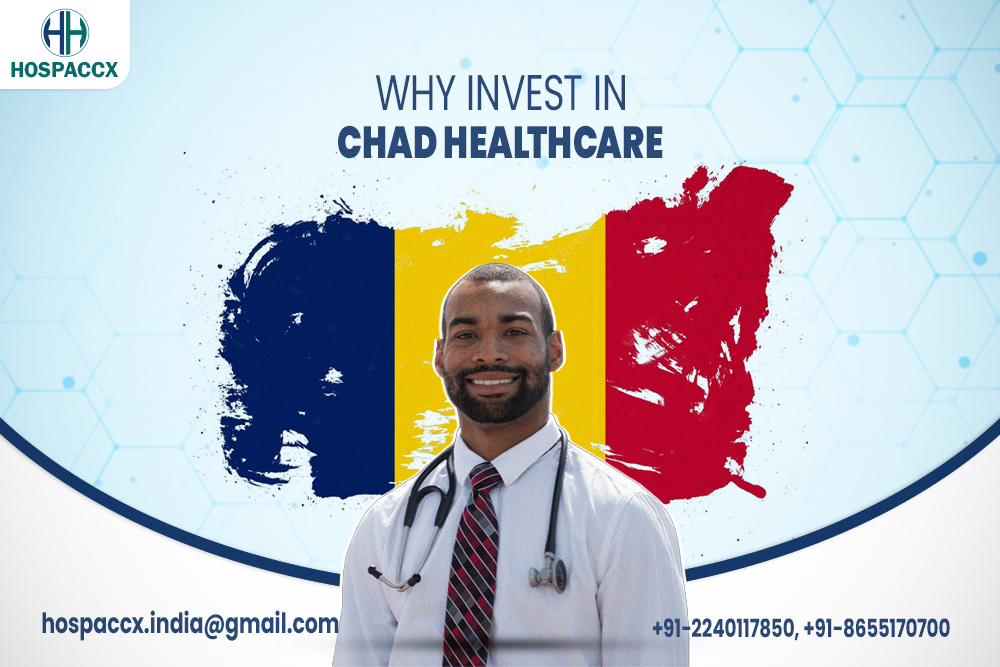WHY INVEST IN CHAD HEALTHCARE
Are you aware of healthcare market scenario of Chad? Are you planning to invest in healthcare of Chad? Hospaccx healthcare business consultancy has mapped all the information related to healthcare scenario of Chad.
If you need a refined market and financial feasibility or any other study related to healthcare is required you can contact Hospaccx Healthcare business consulting Pvt. ltd on Hospaccx.India@gmail.com or you can visit our website on https://hospaccxconsulting.com/
INTRODUCTION
There is increasing consensus that the right to health can provide ethical, policy and practical groundings for the health systems development. The goals of the right to health care congruent with those of health systems development, which are about strengthening health promotion organizations and actions so as to improve public health. The poor shape and performance of the health systems in Chad question the extent of realization of the right to health. Due to its comprehensiveness and inclusiveness, the right to health has the potential of being an organizational and a normative backbone for public health policy and practice. It can then be understood and studied as an integral component of healthy development.
STATISTICS
| Total population (2017) | 15.2 M |
| Per capita GDP (2017) | $1,918 |
| Fertility rate (2017) | 6.7 |
| Total expenditure on health per capita | 79 |
| Total expenditure on health as % GDP | 3.6 |
| FDI Inflow | $662.2 million |
REASONS TO INVEST IN CHAD HEALTHCARE
Government size:
The top individual income tax rate is 60 percent, and the top corporate tax rate is 45 percent. Other taxes include value-added and property taxes. The overall tax burden equals 7.7 percent of total domestic income. Government spending has amounted to 14.8 percent of the country’s output (GDP) over the past three years, and budget deficits have averaged 0.2 percent of GDP. Public debt is equivalent to 46.6 percent of GDP.
Open markets:
The total value of exports and imports of goods and services equals 73.7 percent of GDP. The average applied tariff rate is 16.4 percent, and nontariff barriers significantly hamper trade. The investment framework is inadequate, impaired by ongoing institutional shortcomings. Poor access to credit hinders private-sector growth. The banking system remains highly dependent on the government and state-owned companies.
Infrastructure and sanitary equipment:
The construction of infrastructures and the provision of equipment are the basis of health development. Since 2005, efforts have been made by the Chadian Government in this area. It is as well as from 2005 to 2013, the State has built 86 health centres, 19 Hospitals and 6 regional hospitals.
Biomedical Devices, the computer hardware, refrigeration, the means assemblies are of inputs necessary in the production of health. We note that the region of the Ennedi West and the region of the Salamat have no medical imaging equipment. The region of Sila has an ultrasound device but not of x-ray device. By against the region of the Barh El Gazel does not ultrasound device but has two devices of radiology. It would be desirable to remedy these problems in order to bring all regions at the same level.
CHAD HEALTH EXPENDITURE
As one of the poorest countries in the world, Chad has very limited healthcare resources, with only 4 physicians per 100,000 populations, just one-sixth of the low regional average. This is complemented by 28 nurses and midwives per 100,000 people, who are clearly insufficient to support a country with such vast healthcare needs, particularly as 72 percent of Chadians live in sparsely populated areas outside of urban centers and transportation infrastructure is limited. Government expenditure makes up 54.1 percent of total health expenditure (THE), while private spending makes up the rest. However, 96.2 percent of private health expenditure is paid out of pocket, with only 0.4 percent of (PvtHE) coming from insurance companies and the remainder coming from non-profit entities, charities, and non-governmental organizations (NGOs).
The country is heavily reliant on humanitarian aid to cover a significant portion of its healthcare costs. Nearly 10 percent of total health expenditure in Chad comes from external funding from global organizations, such as the World Health Organization.
EXPENDITURE ON HEALTHCARE – NOW AND IN FUTURE
“Expected” is the future growth trajectory based on past growth.
In 2016, the development assistance for health was $5, government health spending was $8, out of pocket spending was $21 and prepaid private spending was $2, the total spending was $36.
In coming 2050 it is estimated that development assistance for health will be $6, government health spending will be $9, out of pocket spending will be $19, and prepaid private spending will be $2. The total expected spending will be $35.
MEDICAL TOURISM IN CHAD
Visitors to Chad should be prepared by at minimum updating their routine immunizations, such as measles, mumps, and rubella (MMR), diphtheria, pertussis and tetanus (DPT), and poliovirus vaccines. Hepatitis A & B, typhoid, rabies, and yellow fever vaccines should also be updated prior to arrival in the country.
Consult with a physician before your trip about the necessity of meningococcal vaccination depending on the time and destinations of your trip, as outbreaks of meningitis have occurred in the region in recent years.
While pre-travel vaccinations and other preparations are prudent and will improve peace of mind before a visit to Chad, the country’s extremely limited local healthcare means that extra precautions are required before making a trip. Currently, only two clinics, both in the capital city of N’Djamena, offer international standard medical care and both require advance membership and do not allow walk-in patients.
GROWTH IN HEALTHCARE
To improve access to healthcare, strategies should be developed to improve the effectiveness of interventions and HCS should provide financial incentives for those who use services.
Reliance on community mobilization techniques can also be instrumental in improving the use of health services, especially the use of local healthcare centers and district hospitals. The expansion of close-to-people services can reduce physical barriers, while financial barriers may be removed at point of service through increased prepayment and increased responsiveness of providers, as is being done through pay-for-performance approaches at the healthcare center level. Service delivery demands a sufficient workforce. Addressing the shortage and poor distribution of adequately trained staff at PHC level can be done by increasing the number of healthcare workers, implementing task shifting, and increasing allowances for those who work in hard-to-reach areas. The implementation of these measures will increase HS performance and staff motivation. Increasing pay and improving supervision can be ways to address staff motivation.
International SOS:
The International SOS clinic in N’Djamena is a private international standard medical facility, operating in N’Djamena for more than 14 years and is conveniently located in the city center. Comprehensive range of services includes:
- Medical assistance
- AHA Certified training center
- First-aid training
- Emergency services
- Occupational Health services
- Medical Staffing services
SOCIAL PARTICIPATION
Public health has a long tradition of recognizing social participation as an integral part of health promotion. Realizing the RH implies providing individuals and communities with an authentic voice in decisions defining and affecting their well-being. Social participation is an important asset to primary healthcare (PHC) initiatives because, as the primary beneficiary, the community is well-placed to promote its own welfare. Social participation results in greater responsiveness on the part of community members.
HUMAN RESOURCE FOR HEALTH (HRH)
The HRH situation in Chad can be characterized by insufficient quality and quantity of health workers. The situation has changed little over the past 5 years. There is currently an average of
3.7 physicians per 100,000 population and 2.1 nurses and midwives per 100,000 populations, as well as geographic maldistribution of health workers, with 65% of physicians and 35% of nurses and midwives concentrated primarily in 1 region (Ndjamena) (Division de la Formation
(DRH) / Ministère de la Santé Publique (MSP). The need for initial and continuing training for health workers is challenged by an inadequate carrying capacity, lack of qualified teachers and teaching resources. Health worker attrition and demotivation result from inadequate wages and increased cost of living, lack of recognition, absence of career development, inadequate working conditions, and remoteness of certain regions coupled with a lack of transportation.
Current HRH goals include:
- Capacity building of staff managing health worker planning and computerization of HRH at all levels
- Increasing the number of health workers
- Equitable distribution among regional health structures according to standards specified in the strategic plan
- Strengthening capacity and production quality of national health worker training institutions
- Capacity building of mid-career health workers and staff motivation policies
- Establishing regulatory programs for HRH
- Developing a research culture in the health sector
- Establishing a framework for effective coordination; and
- Adopting a clear policy of funding for training.
RIGHT TO HEALTH (RH)
Relying on the right to health (RH) is the bedrock for health systems development brings to the forefront the structural, ethical and technical limitations of health system in Chad. Chad has one of the highest infant and maternal mortality rates of the world, poor access to primary healthcare, a highly hazardous environment, deficiency in coordination, and a permissive epidemiologic surveillance system, coupled with lack of public values and deontological arrangements that determine the functioning of social intuitions. Given all these negative factors, achieving the RH in Chad remains a mere dream.
CONCLUSION:
After the complete analysis of Chad, it is still under the development and many government policies are yet to be formed to develop this particular area. The health scenario can be seen as the biggest growth as there are no such facilities for healthcare for people over here. Going with this project will give us the benefit, giving the infrastructural facilities in terms of healthcare and it will be beneficial for the promoter.
It is the superficial and macro level study for more details kindly contact Hospaccx Healthcare business consulting Pvt. ltd on Hospaccx.India@gmail.com or you can visit our website at https://hospaccxconsulting.com/
Related Team Members










